Introduction
What is DNA?
DNA, or deoxyribonucleic acid, is often referred to as the "blueprint of life." It carries the genetic instructions that dictate how organisms grow, develop, and function. Found in nearly all living organisms, DNA serves as the foundation of heredity, influencing traits such as eye color, height, and even susceptibility to certain diseases. For those new to the topic, understanding DNA is the first step in grasping the complexities of genetics and how life is structured.
The History of DNA Discovery
DNA’s discovery has a fascinating history marked by milestones and breakthroughs. In the mid-20th century, James Watson and Francis Crick unraveled the structure of DNA as a double helix, earning global recognition. Rosalind Franklin’s critical X-ray diffraction images provided the foundation for their work, though her contributions were often overlooked in earlier accounts. These discoveries paved the way for modern genetics, helping us better understand the role DNA plays in heredity and health.
DNA Structure and Function
The Double Helix: DNA's Iconic Structure
DNA's double helix structure is one of the most recognizable symbols in science and a marvel of molecular biology. This twisted ladder-like formation consists of two complementary strands of nucleotides wound around each other, creating a stable and efficient system for storing genetic information. The sugar-phosphate backbone forms the sides of the ladder, while the nitrogenous bases—adenine (A), thymine (T), cytosine (C), and guanine (G)—create the rungs. Base pairing (A with T and C with G) ensures that genetic instructions are copied accurately during DNA replication.
The helical shape of DNA not only makes it compact enough to fit inside the nucleus of a cell but also protects the genetic code from damage. This precise structure enables DNA to serve as a template for replication and transcription, allowing the information it carries to be passed from cell to cell and generation to generation.
